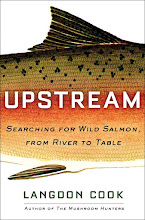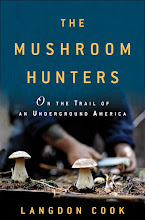Not so. This is the time of year to find cold-loving species such as hedgehogs and winter chanterelles (aka yellowfoot). Look for them in wet coastal woods where there's plenty of decay.
Recently I went picking with a friend on the Olympic Peninsula. Though not an epic year for late-season mushrooms (or any mushrooms, for that matter), we found decent numbers of bellybutton hedgehogs (Hydnum umbilicatum, pictured above and left) and spreader hedgehogs (Hydnum repandum). They're easily told apart. The bellybuttons are smaller, with proportionally longer stems and an "inny" of a bellybutton at the center of the cap, technically referred to as umbilicate. The spreaders can be much larger, with caps that develop scales or cracks. Both are delicious, with spicy hints of black pepper, nutmeg, and cardamon. Being fairly cold-tolerant, they'll last a long time in your fridge, too, often more than a week.
Yellowfoot chanterelles (above), also known as winter chanterelles, are not actually in the chanterelle genus; rather, they're considered a species of Craterellus, the same genus as black trumpets, and like that mushroom, they too are hollow, though with chanterelle-like ridges underneath the cap. In the Pacific Northwest our species is currently called Craterellus tubaeformis but may be changed to C. neotubaeformis as it appears to differ from the species found in the Eastern U.S. and Europe. Either way, yellowfoots have good chanterelle-like flavor despite their insubstantial size, and when they're on, you can pick them by the handful.
Recently I made two appetizer dishes with winter mushrooms. One was a crostini with yellowfoot and chicken liver. The other was a very rich and savory mushroom parfait of sautéed hedgehogs and yellowfoot with wheat berries and mascarpone.
The crostini was inspired by a meal I had at Jeremy Faber's house. Jeremy is the owner of Foraged and Found Edibles in Seattle and I think he served this dish because I had been bad-mouthing yellowfoots as soggy, tasteless chanterelle wannabes. He showed me that with the right approach, you can actually get a lot of flavor out of them, and despite the flimsy, wet noodle posture, they have good texture when properly cooked.
Brown a small handful of chicken liver in vegetable oil. Remove from the pan and crumble with the help of a potato masher. In the same pan, sauté a few big handfuls of whole yellowfoot mushrooms and deglaze with a healthy splash of soy sauce. Cook the mushrooms down in the soy until they release all their water and they're brown. They'll look almost like weird, squid-like tentacles. No need to add salt because the soy will be plenty salty; in fact, you might want to use a low-sodium variety. Mix back in the crumbled liver and serve over sliced and toasted baguette with a sprinkling of chopped parsley. The result is a serious umami bomb.
For the parfait, first prepare the wheat berries on the stove top. No matter how long you cook them they'll retain an al dente texture. I used three cups of chicken stock for a cup of berries and simmered in excess of an hour. This was much more than I needed. Next sauté a half-pound of chopped hedgehog and yellowfoot mushrooms in butter with a generous variety of chopped herbs (I used thyme, sage, and oregano). Season to taste. Remove to a bowl and mix in a few dollops of mascarpone. The mixture should be super creamy. Now mix in enough wheat berries so that the ratio is about 3:1 in favor of mushrooms. Serve in goblets with a sprinkling of chives on top.
The season's not over for those of us north of Oregon. Get out there and find some mushrooms.
























